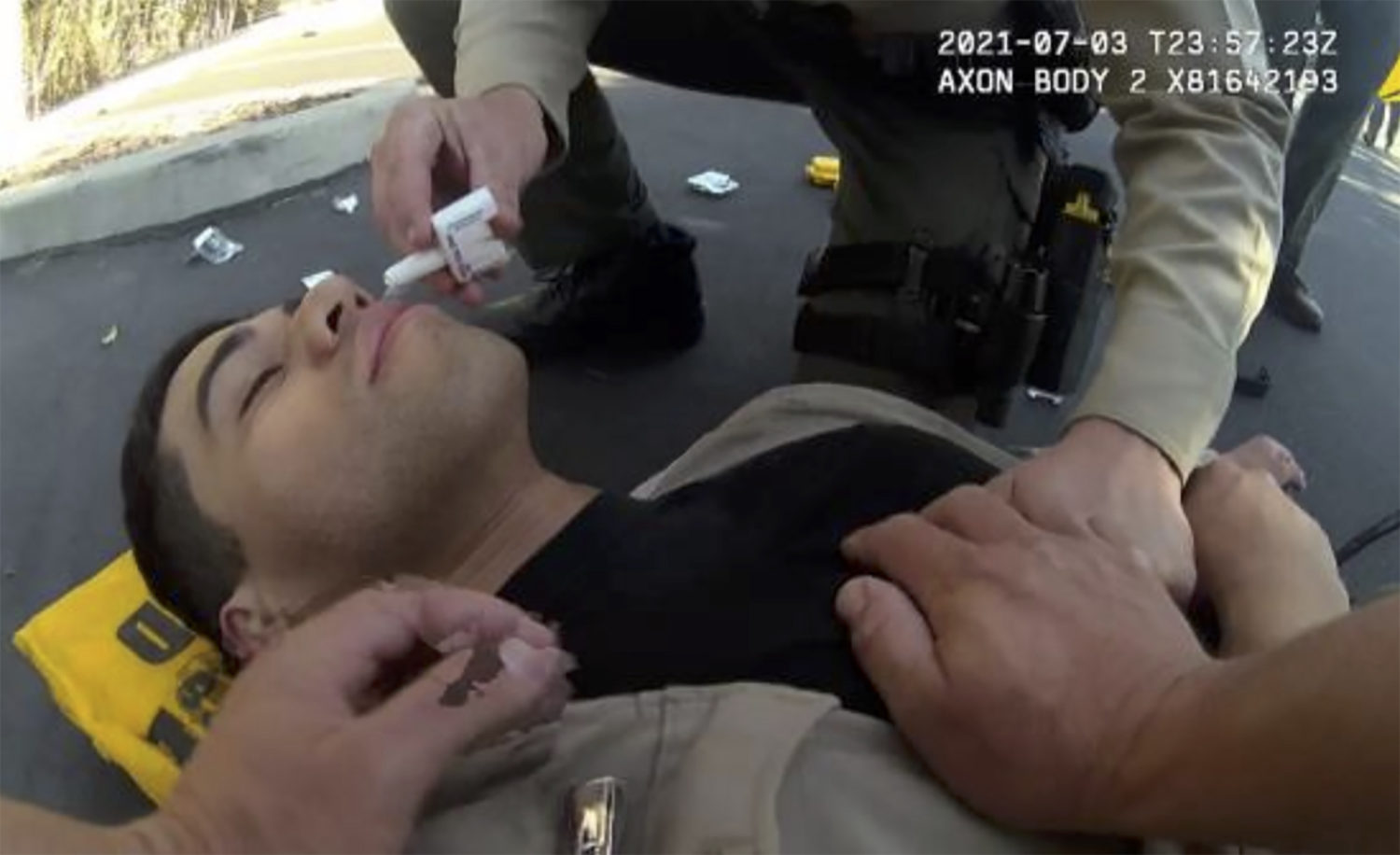On Aug. 5, The San Diego Union-Tribune ran a story with the headline “’I’m not going to let you die’: Deputy overdoses after coming into contact with fentanyl.” The story contained an embedded video from a body-worn camera that was edited and shared by the San Diego Sheriff’s Department.
The Union-Tribune was clear about the cause and consequences of Deputy David Faiivae’s supposed collapse after coming into contact with fentanyl. The opening paragraph painted a stark picture: “The accidental fentanyl exposure hit Deputy David Faiivae quickly. It was an overdose. He was dying.”
There’s just one problem. “For all intents and purposes, it is physically and chemically impossible” to overdose from fentanyl merely by touching it, according to Ryan Marino, a doctor specializing in toxicology. “It has never happened.”
Even specifically designed transdermal patches “take 12 or more hours to get a therapeutic dose, let alone an overdose,” Marino said.
In the video, Cpl. Scott Crane, Faiivae’s partner, says Faiivae collapsed in “a couple of seconds.” Despite a preponderance of evidence, the myth that fentanyl can cause an overdose merely through touching it is so common that the American College of Medical Toxicology and American Academy of Clinical Toxicology issued a joint position on the transdermal absorption of fentanyl that states that “even a high dose of fentanyl prepared for transdermal administration cannot rapidly deliver a high dose.”
Marino also noted that Faiivae did not display symptoms consistent with an overdose. “I have seen hundreds of opioid overdoses,” Marino said. “The features he displayed are not consistent with an opioid overdose.”
An overdose is a clinical diagnosis, one that Marino said could be confirmed in a laboratory or by assessing symptoms, but neither of these categories seems to have been met. The San Diego Sheriff’s Department did not respond to a request for comment on whether Faiivae was tested on arrival at the hospital. But in a later interview, Sheriff Bill Gore confirmed that it was him, and not a medical professional, who made the “diagnosis”.
Marino also noted that the four doses of Narcan, an anti-opioid-overdose medication, administered to Faiivae by his partner in an eight-minute period “would never be necessary.” Yet the story stated that Faiivae “was overdosing all the way to the hospital,” suggesting that he did not respond in the 17 minutes between his first dose and the departure of the ambulance.
[the_ad id=”667826″]
Claire Zagorski, program coordinator of the pharmacy addictions research and medicine at The University of Texas at Austin, said that sharing what she called “social contagion” narratives around fentanyl can and does result in negative public health outcomes.
“If you keep seeing news reports where grown men are taken down in moments by being near this medicine, it makes absolute sense that laypeople are not going to be willing to touch someone having an overdose and give them Narcan,” Zagorski said. “I don’t think that is the point, but it is a very logical outcome and it is really heartbreaking.”
The erroneous assumption that fentanyl is causing officers to collapse often leads to people who use the drug being charged with endangering an officer, Marino said.
Zagorski, who has practiced as a paramedic, speculated that widespread misreporting around fentanyl might be the cause of Faiivae’s unfortunate and doubtless traumatic collapse.
“This is not terribly unique,” she said. “What it looks really consistently to be is an anxiety reaction. We will see people breathing quickly and shallowly, they break out in a cold sweat, they often say their hands and feet were tingling. I do believe that happened to you, and that you felt that, and that you fainted, and you went down. I am saying that is an anxiety reaction. If you had been exposed to fentanyl to the point that it caused an overdose, you would not be breathing quickly.”
The experience was undoubtedly traumatic for both Faiivae and Crane, and neither is to blame for their reactions, but journalists uncritically parroting police language around public health puts both police and members of the public in danger. The Union-Tribune also still sometimes uses the passive voice to refer to “officer-involved shootings” in the city, though a staff member reached out to clarify that the Union-Tribune classified “officer-involved shooting” as police jargon that should be avoided in a stylebook update on April 8, 2020.
The story appeared in a number of other publications, including the Los Angeles Times, Fox 5 San Diego, ABC News and the Daily Mail. Dozens of other outlets also shared the story, all without fact-checking or comment from a medical expert. Both NBC and The New York Times provided context questioning the veracity of the police account.
Teri Figueroa and Karen Kucher, who authored the Union-Tribune piece, did not respond to a request for comment. A public records request for their emails to the San Diego Sheriff’s Department has not been released at the time of publication.
In an email to Poynter Sunday afternoon, Union-Tribune publisher and editor-in-chief of Jeff Light said, “Our journalists apply significant scrutiny to use of force and the ways in which police wield authority in our community. In this particular article, there was no arrest and no use of power — just a story about something bad happening to a sheriff’s deputy. So it seems we let our guard down.” There was, in fact, an arrest in this case.
Dana Littlefield, public safety editor at the Union-Tribune, clarified that the publication had asked the department a number of questions on Thursday, including, “What happens in a fentanyl overdose?” However, they did not receive responses to many of their questions before publication.
“We understand the criticism about whether a person can overdose from exposure to fentanyl through the skin,” Littlefield said. “This was an omission from our original story, but not a deliberate one. We updated the original story online and we — as well as the L.A. Times — have sent requests to the sheriff’s department for reaction to the criticism as well as more information about the incident itself.”
[the_ad id=”667872″]
On Sunday, the Union-Tribune shared a Los Angeles Times story (both publications are owned by Dr. Patrick Soon-Shiong) about doubts that had been cast on the veracity of the diagnosis in the video, but did not mention that both newspapers had uncritically shared it. On Monday, the Union-Tribune acknowledged their reporting had “come under fire.” Then, on Tuesday, the Union-Tribune appended a sidebar to the original story labeled “for the record” that notes: “This story misstates what was known about the medical condition of the deputy shown in the Sheriff Department’s video. The conclusion that his collapse was caused by contact with fentanyl was supplied by the Sheriff’s Department rather than by qualified medical experts, who have since cautioned that the risks from incidental contact are often overstated. A follow-up story can be found here.” The headline continues to read, “Deputy overdoses after coming in contact with fentanyl.”
San Diego Sheriff’s Department spokeswoman Amber Baggs was unable to share a blood toxicology report for Faiivae, citing HIPAA protections. Those have exemptions for law enforcement. Baggs also requested that I “gather all of the facts about the dangers of Fentanyl and not just rely on the American College of Medical Toxicology information” and sent links to four pages: the Drug Enforcement Administration, the National Forensic Laboratory Information System, drugabuse.gov, and the Centers for Disease Control and Prevention. None of these pages contained any evidence of or warning about transdermal absorption of fentanyl.
Baggs also noted that the powder was tested and was fentanyl, which does not prove that Faiivae ingested the powder. The attempt on the part of the sheriff’s department to both-sides a subject that is settled science suggests that the department sees this as more of a political issue than a medical one.
Baggs also confirmed that Faiivae was fine, but told NBC News that he had left the country and was not available. She also confirmed that one man had been arrested and charged with four drug charges, burglary and vandalism.
As online criticism was directed at the San Diego sheriff, Clovis Police Department released a statement claiming that two of their officers had overdosed. Again the statement did not contain any of the symptoms one might expect from an overdose.
Both Zagorski and Marino said well-researched and fact-checked reporting around fentanyl can have a huge public health benefit. Rather than just conveying the deadliness of fentanyl, Zagorski said that basic information about how to spot and treat a seizure can save lives.
If you suspect someone is having an overdose, Zagorski says that “slow, shallow breathing is the biggest problem. You might also see cool, clammy skin that is grayish or dusky, vomiting, and another big thing we see is pinpoint pupils; they are very small.”
It is easy to treat an overdose. Naloxone, sold under the brand name Narcan, is “literally safer than Tylenol. I couldn’t design a better medication to be distributed to laypeople,” Zagorski said, adding that it is safe to give to anyone and if you don’t need Narcan it will simply be metabolized with no side effects.
Marino said “the best thing to do is carry Narcan. As long as you are not snorting, injecting or ingesting fentanyl, it is not going to pose a risk to you.”
“But being prepared to save someone’s life with Narcan is very important,” he said. “We lost 93,000 people last year to overdose.”
Resources for obtaining and training to use Narcan safely can be found at nextdistro.org.
[the_ad id=”667878″]
Clarification: This article was updated to note that the Union-Tribune updated its stylebook to advise avoiding the term “officer-involved shooting,” and that the Union-Tribune appended a note to the original article to note it “misstates what was known about the medical condition of the deputy.”







